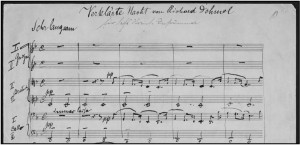The following is a guest post from David H. Plylar, Producer in the Concert Office.

Arnold Schoenberg's holograph score for "Verklarte Nacht" (Photograph used by permission of Belmont Music Publishers).
For those who love music and the people who create it, it would be difficult to match some of the perks of working at the Library of Congress. Perhaps the most rewarding, artistically and intellectually, is having the opportunity to study manuscripts and other composer materials.
I recently had the chance to sit with the holograph manuscript of Arnold Schoenberg’s Verklärte Nacht (Transfigured Night, 1899), in preparation for a talk about the work. I confess to a reverence for most musical monuments, and being able to look at Schoenberg’s original work is something of a sacramental experience. I was mildly taken aback at the lack of expected auto-luminosity when the score was unwrapped, but recovered swiftly as the music was revealed.
Others have written about the differences between the manuscript of Verklärte Nacht and the published sextet (and by extension the version for string orchestra (1917) and its later revision in 1943). However, seeing those differences in print is quite different from seeing them in Schoenberg’s hand. Occasionally one finds corrections that have been attached with thread, and a peek beneath reveals that Schoenberg’s revisions were motivated by considerations both dramatic and motivic. In other places he wrote music that does not make it into the final version, or appears in a different key. What one sees, essentially, is the process of composition; it is a glimpse of a great composer at work.
It is a humanizing experience to witness the process of revision, and an excellent reminder that familiar scores could easily have adopted a different form, for better or worse. A study of a work’s origins helps one to better appreciate the qualities of the final version, and the amount of thought that it took to produce the artwork.
The manuscript of Verklärte Nacht and Brahms’ first sextet for strings will be on display to the public before the performance of these works by Pamela Frank, Alexander Simionescu, Nobuko Imai, Nokuthula Ngwenyama, Peter Wiley and Edward Arron on Wednesday, October 10 in the Coolidge Auditorium at the Library of Congress.
Event Listing
Pamela Frank and Alexander Simionescu, violin;
Nobuko Imai and Nokuthula Ngwenyama, viola;
Peter Wiley and Edward Arron, cello
Wednesday, October 10, 2012, 8:00 p.m. – Jefferson Building, Coolidge Auditorium
DVOŘÁK: Miniatures for two violins and viola, op. 75a
SCHOENBERG: Verklärte Nacht, op. 4
BRAHMS: Sextet in B-flat major, op. 18
Pre-concert presentation:
Developing Variations: Brahms, Schoenberg and Verklärte Nacht
6:15 p.m. – Jefferson Building, Whittall Pavilion
